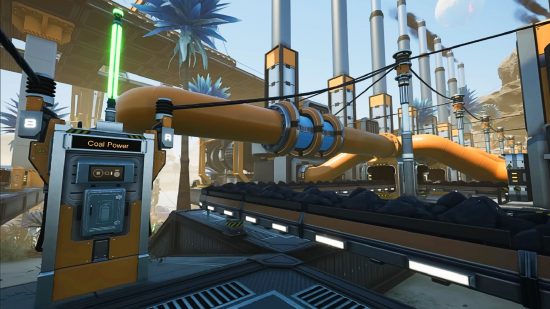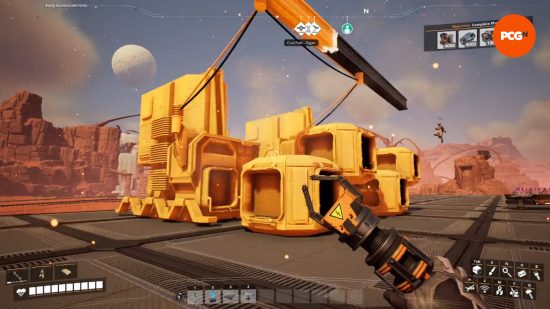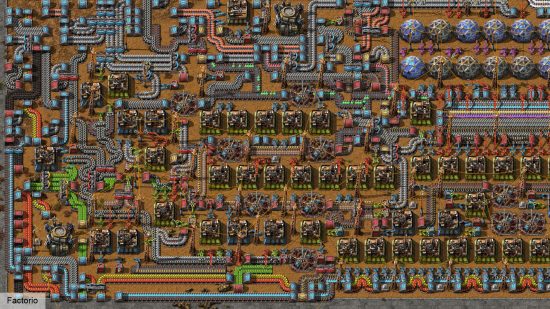Satisfactory is a fantastic success story. From its early access launch in March 2019 to the announcement just two weeks ago that version 1.0 would be releasing in 2024, developer Coffee Stain Studios has continued to build an open-world sandbox game that’s truly special, carving out its own segment alongside the likes of Factorio, Minecraft, and Terraria as a casual-friendly building game with an immense sense of potential. With 5.5 million copies sold, an ‘overwhelmingly positive’ 97% Steam rating, and its full release set for later this year, PCGamesN speaks to community manager Snutt Treptow about what the future holds.
Satisfactory update 8 marks the latest leap for one of the best sandbox games on PC, as the team continues working on its transition to Unreal Engine 5, and I take a tour around the team’s in-game demo factory to chat about how things are going. The latest update runs on UE5.2, although Treptow tells me the team is now internally working on 5.3, which he says “sets us up better for the future.” That’s exciting news for the potential growth of Satisfactory, although it’s come with some caveats.
Chief among those is a bump to the minimum system requirements, which has left some players on older systems behind. Treptow says this was unfortunate, but the team decided it was “going to benefit more people by moving forward.” As a comparison point, he notes the factory reveal in the game’s first trailer, which he says “barely ran” at the time – “now that factory’s nothing, it’s tiny.”

That technology leap allows for plenty more improvements, such as new level streaming, designed to be more streamlined rather than the previous method of loading and unloading large chunks at a time, which makes getting around much smoother. Unreal Engine 5’s Nanite technology gives the textures a welcome visual boost, and there’s even an option to turn on Lumen for advanced lighting, which the team describes as experimental.
“We felt, let’s just add it to the game, it’s not going to break anything, but it might look weird in certain situations and we haven’t tuned the lighting for it and we’re not sure if we will,” Treptow explains. He’s a big fan, however. “It looks really nice… It’s hard to switch it off, once you’ve turned it on.” I’ve got to agree; I’d mostly been playing without it, but seeing it in action is certainly a worthwhile upgrade.
Update eight’s big showpiece addition was the priority power switch, which lets you hook up various outputs in order of importance. In theory, this is designed to ensure you don’t run into any major issues in the case of a power shortage – you can, for example, ensure that your coal power plant is kept running in the event of a power outage, avoiding the need to kickstart its production once again.
“This was something we were working on for a long time – I think it was supposed to come in update four,” Treptow says. Despite this long development time, once it actually arrived it didn’t take long for players to find other interesting ways to use it. One such example is setting up material transport networks using the switch, and then remotely activating a line to have its train bring resources to your current location.
“I don’t know if we anticipated that,” Treptow tells me. He says seeing the way the community reacts to new additions is one of the most fun parts of development and being in early access, saying the team will often make something knowing, “we don’t fully grasp the full potential of what this can bring to the game.”
Another popular example of this are the hypertubes. These transport pipes are somewhat akin to those classic suction tubes, but they actually work by having you (or objects) blasted into them using fans. These are modeled in-game using physical force, Treptow notes, which quickly led players to stack multiple fans up for extra speed – and, ultimately, to create human cannons that allow you to reliably fire yourself huge distances across the map. “I wish we’d have thought of that,” Treptow laughs as we soar across the factory.

“We have a huge backlog of ideas,” he muses, “We’ve worked on this game for almost eight years now.” One of the benefits of early access, he says, is watching the community respond to developments. “We get to confirm our ideas – or when modding creates something we were thinking of implementing, it confirms our belief that it was a good idea.” He pauses. “Or shows that it didn’t work in the way we thought it would, but it’s cool that there’s a mod for that and people have options to choose it.”
Also recently introduced is the Satisfactory ‘advanced settings’ mode, which allows you to essentially switch a save into a full creative mode that allows you to turn off resource restrictions, make yourself invulnerable, and even give yourself materials at will. It’s probably not how most people will play, but Treptow says Coffee Stain is happy to find ways to make the game appealing to a wider audience – though they’re careful to determine when they want to align with community desires and when to put a foot down.
Initially, the plan was for a very Minecraft-style insistence on placing every single block down by hand, encouraging the feeling of building it all yourself. Over time, the team has relented slightly, implementing drag-and-drop mass placement of cosmetic field pieces, and the creation of small-scale blueprints. “Rather than a copy paste feature, it becomes a sort of minigame where it comes down to figuring out how to modularly build your factory.”
Conversely, when faced with players asking for lights to be added, the team instead considered the root cause of the problem. “The problem wasn’t that we didn’t have lights, the problem was that the game was so dark and the lighting wasn’t good. So we wanted to solve the problem of tuning the lighting,” Treptow explains. “But then we also added lights because lights are cool.”
They’re not looking to implement the likes of a logic system, however. Treptow says it’s something the team has spent time toying around with, but came to the conclusion that, “This doesn’t fit the vibe of the game that we’ve made, it’s a bit too complicated, and if we make it an optional thing it’s not worth developing at the moment.”
I ask how the team sees itself fitting alongside the likes of Factorio, which has recently embraced increasingly more complex build tools. “I think the people that like Factorio are way into that type of game and they want more of that complexity,” Treptow responds. “In our case, we’re more towards the casual side of things where we need to figure out where we draw the line of what is too complex.” He says logic systems are “a good example of our different player groups – the different games shine in different aspects.”
Our time running short, I ask what community builds have caught the team’s eye lately. Treptow points to a recent Ficsmas special (the game’s holiday event) from ‘BLAndrew575’ that built and – using the help of a mod – launched 100,000 firework rockets a minute. “It made the game run at three fps, but he did it. It’s amazing that people go to these lengths just to make these absurdly big factories that are not really playable, but they did it.”
That’s no exaggeration either – in fact, three fps might be a bit of an overestimation. But that’s the beauty of Satisfactory’s most ambitious builders. You can watch the result in action below, with BLAndrew575 cackling at the chaos they’ve created. “This is so ridiculous – this is why I build these things. This is so over-the-top unnecessary and ridiculous, and I wouldn’t change a thing.”

With just two minutes left of our tour, there’s one final question I feel almost obligated to ask – if the team is never going to add golf (a long-running joke among the community kicked off by Coffee Stain itself), which sport would Treptow most like to see in Satisfactory? He laughs. “I’m super into disc golf, so if we can meet halfway,” he says.
“We tried to kill off that meme,” he laments with a chuckle, “but people always hang onto it. But it’s funny, because pipes used to be the same kind of joke – and then we joked about that for a year, and then update three was that we added pipes to the game. Sometimes things happen that you didn’t expect to happen.”
Expect the unexpected, then. Satisfactory 1.0 is set to launch later in 2024, but we’ve got more of the best building games and the best simulation games on PC to keep all your sandbox crafting needs fulfilled until then. Or just play some more Satisfactory – I think I’ll be doing just that.
You can also follow us on Google News for daily PC games news, reviews, and guides, or grab our PCGN deals tracker to net yourself some bargains.



